No bodily function is off-limits for Canadian astronaut Chris Hadfield. In this video, he explains that in space, you need REALLY good barf bags.
Of course, Hadfield previously gave the best description ever of how to go to the bathroom in space.

Space and astronomy news
No bodily function is off-limits for Canadian astronaut Chris Hadfield. In this video, he explains that in space, you need REALLY good barf bags.
Of course, Hadfield previously gave the best description ever of how to go to the bathroom in space.
Have you ever wondered what it would be like to stand on the surface of Mars, or stare up at one of Saturn’s rings from the mountains of Titan? The Luminos App by Wobbleworks affords you the opportunity to give your friends a guided tour of the universe from the convenience of your iOS device. You can examine deep space objects, track satellites and fast forward or reverse time to understand the orbit of planets around the sun. If disaster movies don’t scare your pants off, you can view Near Earth Asteroids to see how many near misses the Earth has every year!
Wobbleworks provides an excellent user guide to this app complete with pictures and tutorials on how to create your own Observation Lists, log the date and time that a celestial body was viewed and keep track of satellites. It is really quite interesting to note the pass of the International Space Station.
Wobbleworks and Universe Today are giving away 10 free copies of Luminos!
This Giveaway is Now Closed
This giveaway will run for a week starting today, so get your entries in! How?
In order to be entered into the giveaway drawing, just put your email address into the box at the bottom of this post (where it says “Enter the Giveaway”) before Thursday, May 2, 2013. We’ll send you a confirmation email, so you’ll need to click that to be entered into the drawing.
Words from Brian Albers – Luminos Developer: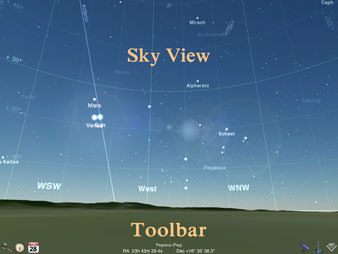
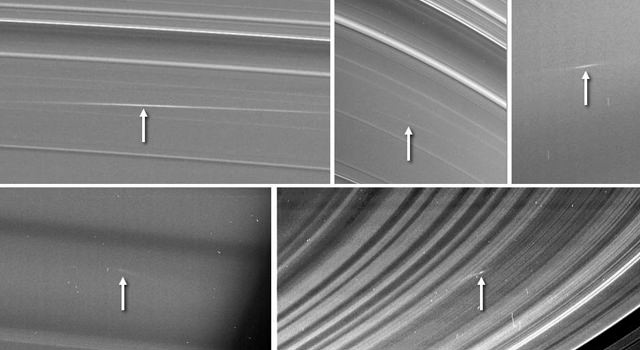
From tell-tale evidence, we know that Earth, our Moon and other bodies in our Solar System are constantly barraged with both small meteoroids and larger asteroids or comets. And sometimes – like in the case of seeing meteors fling across our sky, or flashes on the Moon or Jupiter getting hit by Comet Shoemaker-Levy 9 — we even get to watch as it happens. Now, for the first time the Cassini spacecraft has provided direct evidence of small meteoroids crashing into Saturn’s rings.
Researchers say that studying the impact rate of meteoroids from outside the Saturnian system helps scientists understand how different planet systems in our solar system formed.
Saturn’s rings act as very effective detectors of many kinds of surrounding phenomena, including the interior structure of the planet and the orbits of its moons. For example, a subtle but extensive corrugation that ripples 12,000 miles (19,000 kilometers) across the innermost rings tells of a very large meteoroid impact in 1983.
“These new results imply the current-day impact rates for small particles at Saturn are about the same as those at Earth — two very different neighborhoods in our solar system — and this is exciting to see,” said Linda Spilker, Cassini project scientist at NASA’s Jet Propulsion Laboratory in Pasadena, Calif. “It took Saturn’s rings acting like a giant meteoroid detector — 100 times the surface area of the Earth — and Cassini’s long-term tour of the Saturn system to address this question.”
The Saturnian equinox in summer 2009 was an especially good time to see the debris left by meteoroid impacts. The very shallow sun angle on the rings caused the clouds of debris to look bright against the darkened rings in pictures from Cassini’s imaging science subsystem.

“We knew these little impacts were constantly occurring, but we didn’t know how big or how frequent they might be, and we didn’t necessarily expect them to take the form of spectacular shearing clouds,” said Matt Tiscareno, lead author of the paper and a Cassini participating scientist at Cornell University in Ithaca, N.Y. “The sunlight shining edge-on to the rings at the Saturnian equinox acted like an anti-cloaking device, so these usually invisible features became plain to see.”
Tiscareno and his colleagues now think meteoroids of this size probably break up on a first encounter with the rings, creating smaller, slower pieces that then enter into orbit around Saturn. The impact into the rings of these secondary meteoroid bits kicks up the clouds. The tiny particles forming these clouds have a range of orbital speeds around Saturn. The clouds they form soon are pulled into diagonal, extended bright streaks.
“Saturn’s rings are unusually bright and clean, leading some to suggest that the rings are actually much younger than Saturn,” said Jeff Cuzzi, a co-author of the paper and a Cassini interdisciplinary scientist specializing in planetary rings and dust at NASA’s Ames Research Center in Moffett Field, Calif. “To assess this dramatic claim, we must know more about the rate at which outside material is bombarding the rings. This latest analysis helps fill in that story with detection of impactors of a size that we weren’t previously able to detect directly.”
Source: JPL
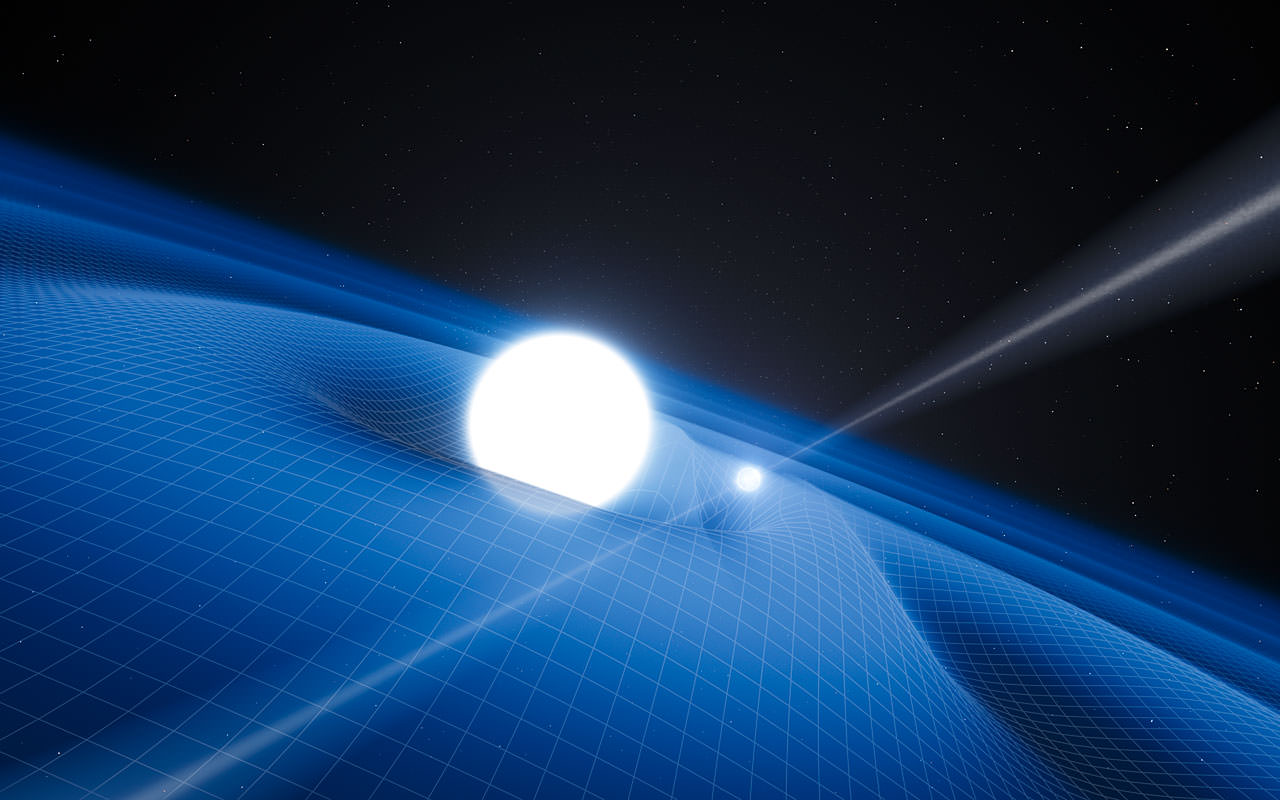
A unique and exotic laboratory about 6,800 light-years from Earth is helping Earth-based astronomers test Albert Einstein’s theory of general relativity in ways not possible until now. And the observations exactly match predictions from general relativity, say scientists in a paper to be published in the April 26 issue of the journal Science.
Using ESO’s Very Large Telescope along with other radio telescopes, John Antoniadis, a PhD student at the Max Planck Institute for radio Astronomy (MPIfR) in Bonn and lead author of the paper, says the bizarre pair of stars makes for an excellent test case for physics.
“I was observing the system with ESO’s Very Large Telescope, looking for changes in the light emitted from the white dwarf caused by its motion around the pulsar,” says Antoniadis. “A quick on-the-spot analysis made me realize that the pulsar was quite a heavyweight. It is twice the mass of the Sun, making it the most massive neutron star that we know of and also an excellent laboratory for fundamental physics.”
The strange pair consists of a tiny and unusually heavy neutron star that spins 25 times per second. The pulsar, named PSR J0348+0432 is the remains of a supernova explosion. Twice as heavy as our Sun, the pulsar would fit within the confines of the Denver metropolitan area; it’s just 20 kilometers across or about 12 miles. The gravity on this strange star is more than 300 billion times stronger than on Earth. At its center, where the intense gravity squeezes matter even more tightly together, a sugar-cubed-sized block of star stuff would weight more than one billion tons. Only three other pulsars outside globular clusters spin faster and have shorter periods.
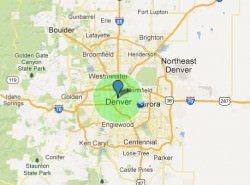
As a consequence, radio astronomers Ryan Lynch and colleagues who discovered the pulsar in 2011, realized the pair would enable scientists to test theories of gravity that were not possible before. Einstein’s general theory of relativity describes gravity as a curvature in spacetime. Like a bowling ball nestled in a stretched bedsheet, spacetime bends and warps in the presence of mass and energy. The theory, published in 1916, has withstood all tests so far as the simplest explanation for observed astronomical phenomena. Other theories of gravity make different predictions but these differences would reveal themselves only in extremely strong gravitational fields not found within our solar system. J0348+0432 offered the opportunity to study Einstein’s theory in detail.
This video shows an artist’s impression of the exotic double object known as PSR J0348+0432. This system is radiating gravitational radiation, or ripples, in spacetime. Although these waves cannot be yet detected directly by astronomers on Earth they can be detected indirectly by measuring the change in the orbit of the system as it loses energy. Credit: ESO/L.Calçada
Antoniadis’ team combined observations of the white dwarf from the European Southern Observatory’s Very Large Telescope with the precise timing of the pulsar from other radio telescopes, including the Green Bank Telescope in West Virginia, Effelsberg 100 meter radio telescope in Germany, and the Arecibo Observatory in Puerto Rico. Astronomers predict such close pulsar binaries radiate gravity waves and lose minute amounts of energy over time causing the orbital period of the white dwarf companion to change slightly. The astronomers found that predictions for this change closely matched those of general relativity while competing theories were different.
“Our radio observations were so precise that we have already been able to measure a change in the orbital period of 8 millionths of a second per year, exactly what Einstein’s theory predicts,” states Paulo Freire, another team member, in the press release.
Sources:
ESO: Einstein Was Right – So Far
Astrophysical Journal: The Green Bank Telescope 350 MHz Drift-scan Survey II: Data Analysis and the Timing of 10 New Pulsars, Including a Relativistic Binary
Aspen Center for Physics Physical Application of Millisecond Pulsars meeting January 2013: The Compact Relativistic Binary PSR J0348+0432
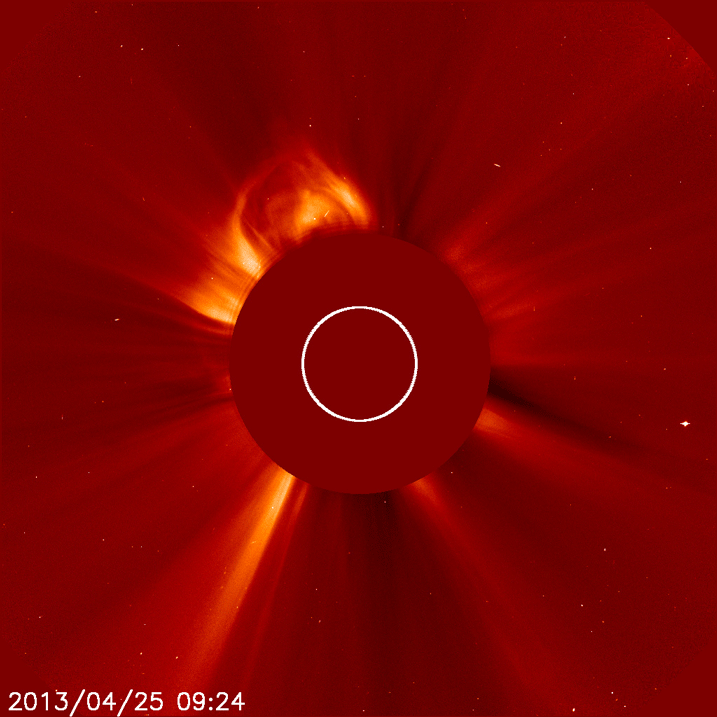
Over the past 24 hours, the Sun has erupted with two coronal mass ejections (CMEs), sending billions of tons of solar particles into space. While these CMEs are not directed at Earth, they are heading towards Mercury and may affect the Messenger spacecraft, as well as the Sun-watching STEREO-A satellites. One CME may send a glancing blow of particles to Mars, possibly affecting spacecraft at the Red Planet.
This solar radiation can affect electronic systems on spacecraft, and the various missions have been put on alert. When warranted, NASA operators can put spacecraft into safe mode to protect the instruments from the solar material.
The first CME began at 01:30 UTC on April 25 (9:30 p.m. EDT on April 24), and the second erupted at 09:24 UTC (5:24 a.m. EDT) on April 25. Both left the sun traveling at about 800 kilometers (500 miles per second).
See this animation from the STEREO-B spacecraft:
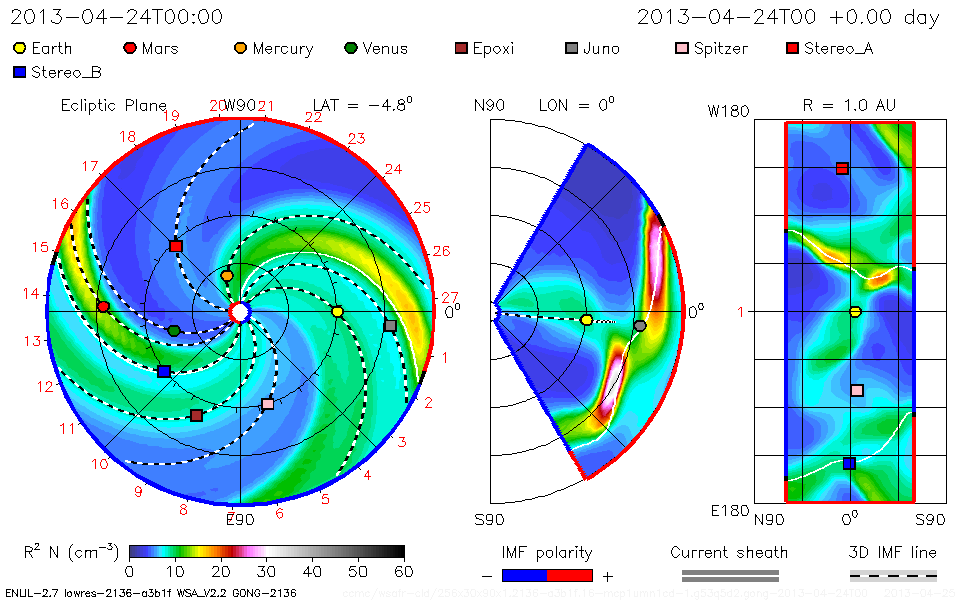
Source: NASA
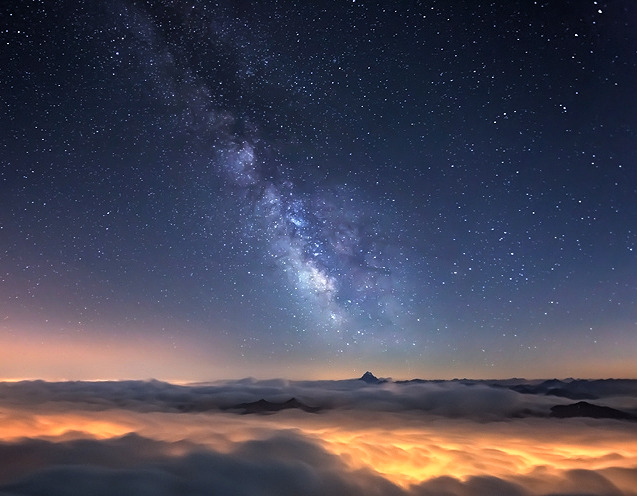
Obtaining an accurate distance between the Sun and the center of our Galaxy remains one of the principal challenges facing astronomers. The ongoing lively debate concerning this distance hinges partly on the nature of dust found along that sight-line. Specifically, are dust particles lying toward the Galactic center different from their counterparts near the Sun? A new study led by David Nataf asserts that, yes, dust located towards the Galactic center is anomalous. They also look at accurately defining both the distance to the Galactic center and the reputed bar structure that encompasses it.
The team argues that characterizing the nature of small dust particles is key to establishing the correct distance to the Galactic center, and such an analysis may mitigate the scatter among published estimates for that distance (shown in the figure below). Nataf et al. 2013 conclude that dust along the sight-line to the Galactic center is anomalous, thus causing a non-standard ‘extinction law‘.
The extinction law describes how dust causes objects to appear fainter as a function of the emitted wavelength of light, and hence relays important information pertaining to the dust properties.
The team notes that, “We estimate a distance to the Galactic center of [26745 light-years] … [adopting a] non-standard [extinction law] thus relieves a major bottleneck in Galactic bulge studies.”
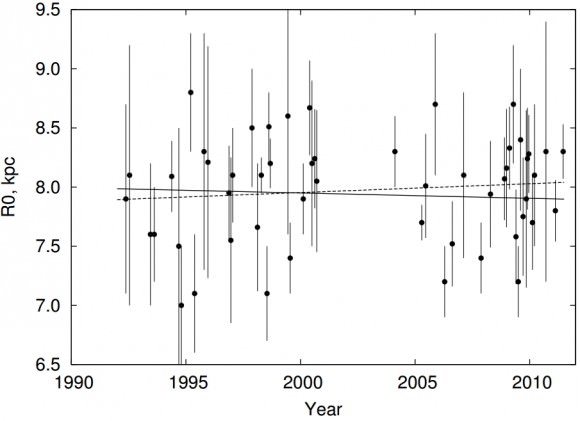
Nataf et al. 2013 likewise notes that, “The variations in both the extinction and the extinction law made it difficult to reliably trace the spatial structure of the [Galactic] bulge.” Thus variations in the extinction law (tied directly to the dust properties) also affect efforts to delineate the Galactic bar, in addition to certain determinations of the distance to the Galactic center. Variations in the extinction law imply inhomogeneities among the dust particles.
“The viewing angle between the bulge’s major axis and the Sun-Galactic centerline of sight remains undetermined, with best values ranging from from 13 to … 44 [degrees],” said Nataf et al. 2013 (see also Table 1 in Vanhollebekke et al. 2009). The team added that, “We measure an upper bound on the tilt of 40 [degrees] between the bulge’s major axis and the Sun-Galactic center line of sight.”
However, the properties of dust found towards the Galactic center are debated, and a spectrum of opinions exist. While Nataf et al. 2013 find that the extinction law is anomalously low, there are studies arguing for a standard extinction law. Incidentally, Nataf et al. 2013 highlight that the extinction law characterizing dust near the Galactic center is similar to that tied to extragalactic supernovae (SNe), “The … [extinction] law toward the inner Galaxy [is] approximately consistent with extra-galactic investigations of the hosts of type Ia SNe.”
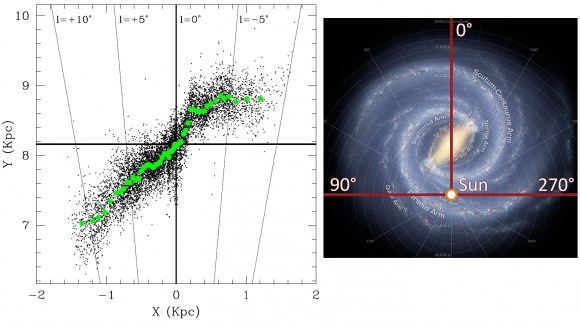
Deviations from the standard extinction law, and the importance of characterizing that offset, is also exemplified by studies of the Carina spiral arm. Optical surveys reveal that a prominent spiral arm runs through Carina (although that topic is likewise debated), and recent studies argue that the extinction law for Carina is higher than the standard value (Carraro et al. 2013, Vargas Alvarez et al. 2013). Conversely, Nataf et al. 2013 advocate that dust towards the Galactic center is lower by comparison to the standard (average) extinction law value.
The impact of adopting an anomalously high extinction law for objects located in Carina is conveyed by the case of the famed star cluster Westerlund 2, which is reputed to host some of the Galaxy’s most massive stars. Adopting an anomalous extinction law for Westerlund 2 (Carraro et al. 2013, Vargas Alvarez et al. 2013) forces certain prior distance estimates to decrease by some 50% (however see Dame 2007). That merely emphasizes the sheer importance of characterizing local dust properties when establishing the cosmic distance scale.
In sum, characterizing the properties of small dust particles is important when ascertaining such fundamental quantities like the distance to the Galactic center, delineating the Galactic bar, and employing distance indicators like Type Ia SNe.
The Nataf et al. 2013 findings have been accepted for publication in the Astrophysical Journal (ApJ), and a preprint is available on arXiv. The coauthors on the study are Andrew Gould, Pascal Fouque, Oscar A. Gonzalez, Jennifer A. Johnson, Jan Skowron, Andrzej Udalski, Michal K. Szymanski, Marcin Kubiak, Grzegorz Pietrzynski, Igor Soszynski, Krzysztof Ulaczyk, Lukasz Wyrzykowski, Radoslaw Poleski. The Nataf et al. 2013 results are based partly on data acquired via the Optical Graviational Lensing Experiment (OGLE). The interested reader desiring additional information will find the following pertinent: Udalski 2003, Pottasch and Bernard-Salas 2013, Kunder et al. 2008, Vargas Alvarez et al. 2013, Carraro et al. 2013, Malkin 2013, Churchwell et al. 2009, Dame 2007, Ghez et al. 2008, Vanhollebekke et al. 2009.
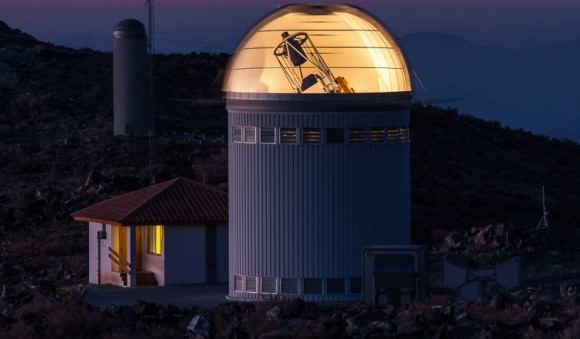
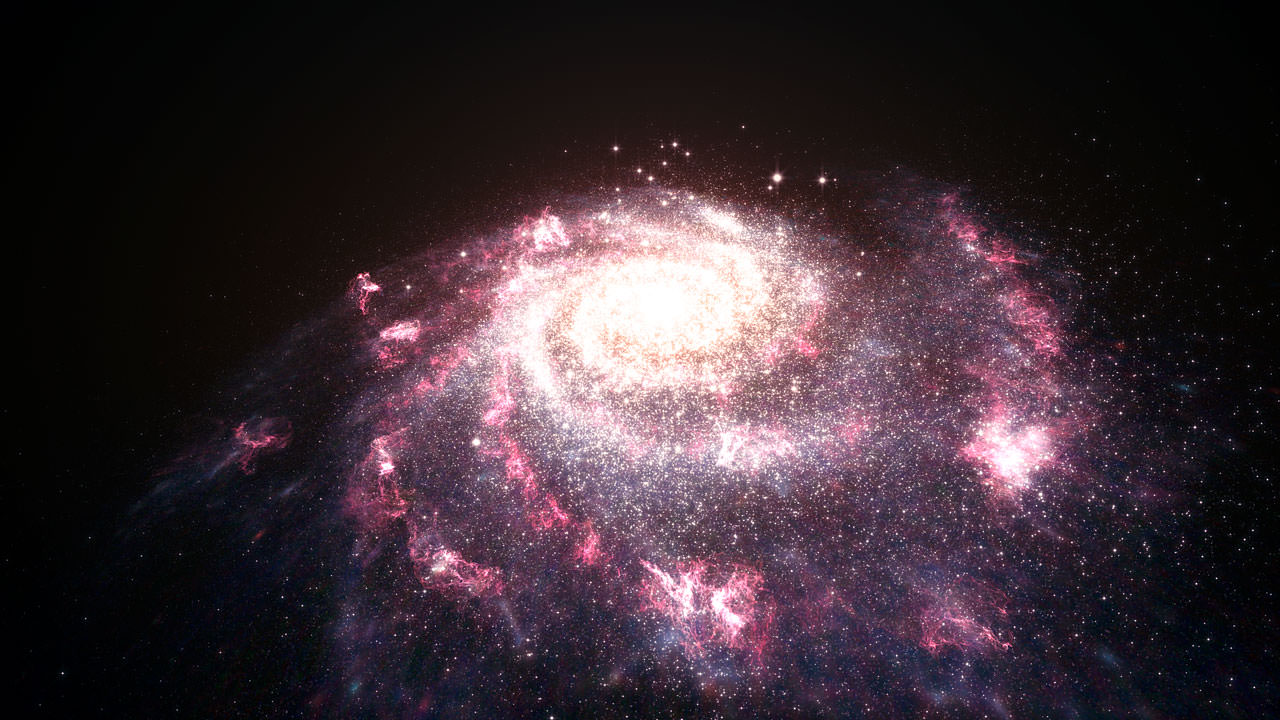
If you think that star-formation only has an impact within the confines of a host galaxy, then think again. Thanks to the magic of the NASA/ESA Hubble Space Telescope, astronomers are now realizing starburst activity can change the properties of galactic gases at distances almost twenty times larger than a galaxy’s visible boundaries. Not only does this affect galactic evolution, but it has ramifications on how matter and energy ripple across the cosmos.
What’s going on here? Once upon a time in the early Universe, galaxies would form new stars in huge blasts of activity known as starbursts. While it happened frequently long ago, it’s much less common now. During these starburst episodes, hundreds of millions of stars spring to light and their combined energy sets off massive stellar winds that push outward into space. While these winds were known to have effects on the parent galaxy, new research shows they have an even greater effect than anyone knew.
Recently a team of international astronomers took on twenty galaxies which are known to be hosting starburst activity. What they found was the starburst stellar winds were able to ionize gas at huge distances – up to 650,000 light years from the galaxy’s nucleus – and around twenty times beyond the galaxy’s visible perimeter. For the first time, researchers were able to verify that starburst activity could impact the gas around the parent galaxy. This new observational evidence shows just how important each phase a galaxy goes through can impact the way it form stars and how it evolves.
“The extended material around galaxies is hard to study, as it’s so faint,” says team member Vivienne Wild of the University of St. Andrews. “But it’s important — these envelopes of cool gas hold vital clues about how galaxies grow, process mass and energy, and finally die. We’re exploring a new frontier in galaxy evolution!”
This animation shows the method used to probe the gas around distant galaxies. Astronomers can use tools such as Hubble’s Cosmic Origins Spectrograph (COS) to probe faint galactic envelopes by exploiting even more distant objects — quasars, the intensely luminous centres of distant galaxies powered by huge black holes. As the light from the distant quasar passes through the galaxy’s halo, the gas absorbs certain frequencies – making it possible to study the region around the galaxy in detail. This new research utilised Hubble’s COS to peer through the very thin outskirts of galactic halos, much further out than shown in this representation, to explore galactic gas at distances of up to twenty times greater than the visible size of the galaxy itself. Credit: ESA, NASA, L. Calçada
So how did they do it? According to the news release, the researchers employed the Cosmic Origins Spectrograph (COS) instrument located on the NASA/ESA Hubble Space telescope. By examining the spectral signature of a variety of starbirth and control galaxies, the team was able to carefully examine the regions of gas surrounding the galaxies. However, they had a little boost, too… quasars. By adding the light of the intensely luminous galactic cores to the mix, they were able to further refine their observations by watching the quasar’s light as it passed through foreground galaxies. This method allowed them to even more closely examine their targets.
“Hubble is the only observatory that can carry out the observations necessary for a study like this,” says lead author Sanchayeeta Borthakur, of Johns Hopkins University. “We needed a space-based telescope to probe the hot gas, and the only instrument capable of measuring the extended envelopes of galaxies is COS.”
The eureka moment came when the astronomers found the starburst galaxies in their samples showed abnormal amounts of highly ionized gases in their halos. By comparison, the control galaxies – those known to have no starburst activity – did not. Now they knew… the ionization had to be the product of the energetic winds which accompanied the birth of new stars. Armed with this information, researchers can now confidently say that galaxies which host starburst activity has taken on new parameters. Since galaxies enlarge by feeding on gas from the space around them and convert this into new stars, we realize that the ionization process will regulate future star formation.
“Starbursts are important phenomena — they not only dictate the future evolution of a single galaxy, but also influence the cycle of matter and energy in the Universe as a whole,” says team member Timothy Heckman, of Johns Hopkins University. “The envelopes of galaxies are the interface between galaxies and the rest of the Universe — and we’re just beginning to fully explore the processes at work within them.”
Burn, baby, burn…
Original Story Source: NASA/ESA Hubble Space Telescope News Release. Further reading: The Impact of Starbursts on the Circumgalactic Medium.
Astronaut pranks are, well, just a part of the job. Often they poke at a sore spot in the astronaut’s history, and Charles Duke found himself the subject of a particularly painful one in the 1970s.
Duke was in the final moments of preparations before climbing into the Apollo 16 spacecraft, which was exploring the Moon in this week in 1972. It was a serious moment as Duke and his crew were about to rocket off to the moon. Then Duke got a surprise, courtesy of backup commander Fred Haise, as Duke recalled in an interview with NASA in 1999.
We were up climbing into the command module on the launch pad, and [launch pad leader] Guenter Wendt and the team were up there. And so John gets in, and I’m the next in on the right side. And as I start to climb in, I reach in and I look over and taped to the back of my seat was a big thing, “Typhoid Mary suit—seat.” So, we had a … laugh over that. Yeah, Fred would never let me forget that.
Typhoid Mary referred to Mary Mallon, a cook who was put under quarantine for the latter half of her life in the 1900s — against her stringent objections. She was accused of passing along typhoid to several families for which she did cooking, even though she didn’t show any symptoms herself. At the time, typhoid had no cure. Her curious story has been the subject of a PBS show and numerous books.
The joke on Duke hearkened back to the ill-fated Apollo 13 two years before, when Duke’s son caught the German measles. Duke fell ill and unwittingly exposed several astronauts during his contagion period — including the upcoming Apollo 13 prime crew of Jim Lovell, Fred Haise and Ken Mattingly.
Of the three crew members, Mattingly had not been exposed to the German measles. This led to Mattingly being yanked from the mission days before launch. Adding to the drama, Apollo 13 suffered an explosion in space that crippled the spacecraft and, without the extraordinary efforts of the astronauts and Mission Control, could have killed the crew.
Anyway, Apollo 13 came back safely, and in 1972 lessons had been learned from the mission. Haise, to his credit, wasn’t afraid to poke a little fun at the early havoc Duke’s illness wreaked on his crew.
What are your favorite astronaut pranks?
Captured on January 15, this narrow-angle Cassini image shows an outer portion of Saturn’s A ring on the left and the ropy F ring crossing on the right. The thin black line near the A ring’s bright edge is the Keeler Gap, a 22-mile-wide space cleared by the passage of Daphnis, a shepherd moon barely 5 miles (about 7.5 km) across. As it travels around Saturn within the gap its gravity perturbs the fine icy particles within the rings, sending up rippling waves both before and behind it — visible here near the upper center.
From Cassini’s distance of 870,000 miles (1.4 million km) Daphnis itself is just barely visible as a single pixel within the Gap — can you see it? If not, click below…
There it is:
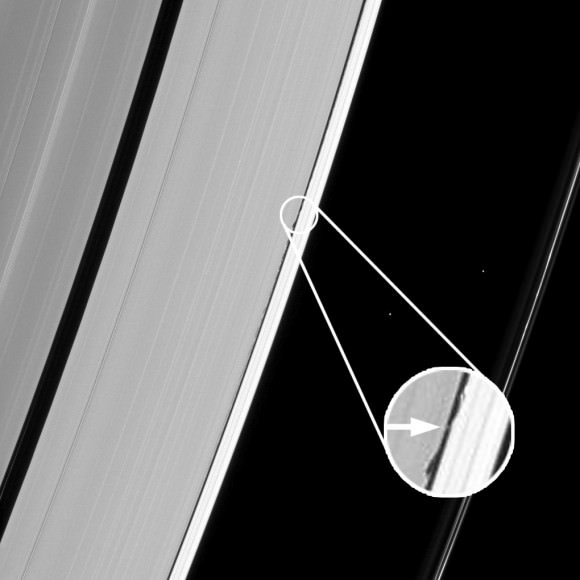
While lacking the murky mystery of Titan’s atmosphere, Enceladus’ dramatic jets and the tortured and cratered surfaces found on Dione, Rhea, Mimas and many of Saturn’s larger icy moons, little Daphnis has always fascinated me because of the scalloped waves it kicks up within Saturn’s rings. Eventually these waves settle back down, but at their highest they can extend a mile or two above and below the ring plane!
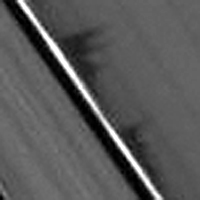
This effect was most pronounced during Saturn’s spring equinox in August 2009 when sunlight was striking the rings edge-on, creating strong shadows from any areas of relief.
Imagine the impressive view you’d have if you were nearby, positioned just above the rings as Daphnis approached and hurtled past, the rings rising up in mile-high peaks from the moon’s gravity before smoothing out again. Incredible!
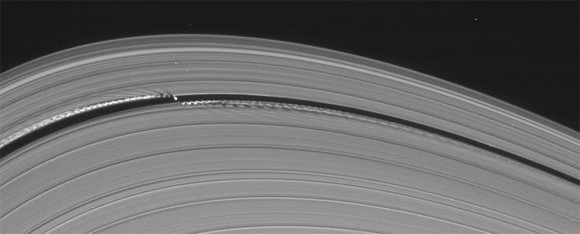
And I’m not the only one to imagine such a scene either — apparently artist Erik Svensson is also intrigued by Daphnis, enough to have been inspired to create the image below. How very cool!
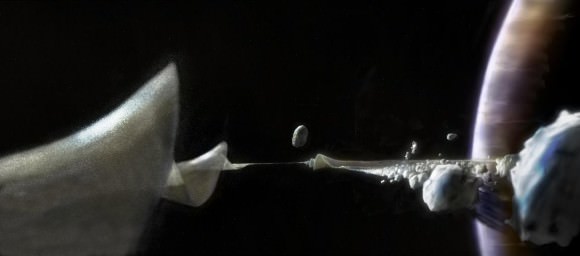
Like its larger shepherd moon sister Prometheus, Daphnis may be little but still has a big effect on the icy stuff that makes up Saturn’s iconic rings.
And for lots more views of Daphnis click here (but watch out, it may just become your favorite moon too!)
Image credits: NASA/JPL-Caltech/Space Science Institute.
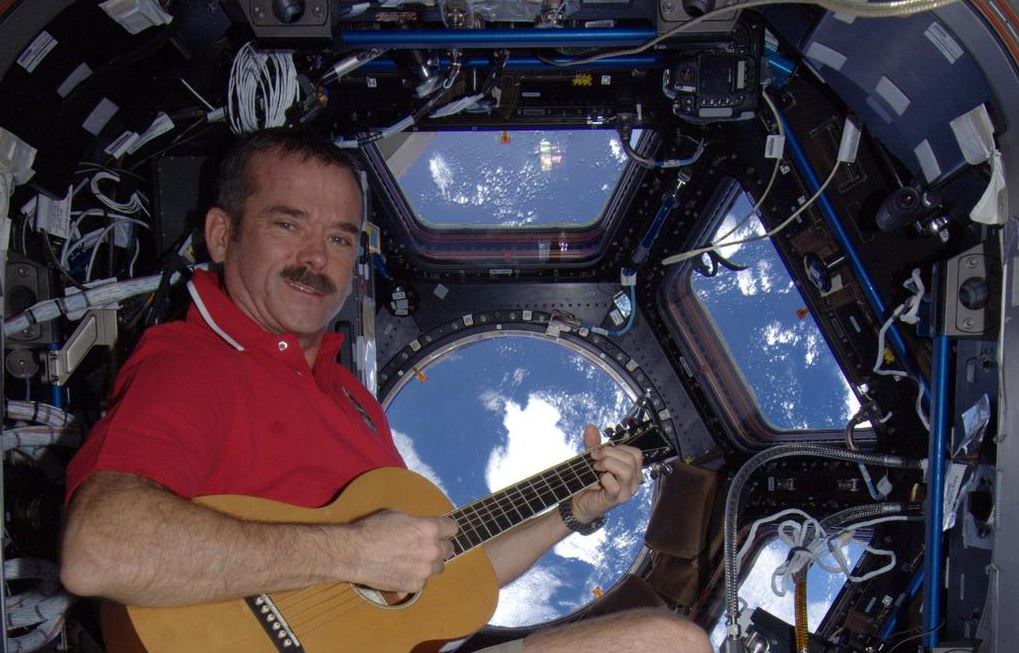
Canadian astronaut Chris Hadfield has been called “the internet’s favorite astronaut” and with over 700,000 followers on Twitter, he may be one of the reasons why space is “hot” these days.
A new show featuring Hadfield’s mission on the International Space Station will air on the Canadian Broadcasting Corporation (CBC) on Thursday, April 25 and then will be available world-wide online on April 26.
UPDATE: The online version of this show is now available on CBC here.
CBC’s The Nature of Things is broadcasting “The Man Who Tweeted Earth,”,which looks at Hadfield’s mission and features other astronauts, scientific collaborators, Hadfield’s secret weapon family member (his son) and the Mission Control staff at the Canadian Space Agency and NASA.
Also, Universe Today is proud to say that our own Elizabeth Howell is also part of this broadcast, and she’s event featured on this trailer from the CBC!:
“Essentially, I talk about the techniques Hadfield uses to keep people engaged,” Elizabeth told me, as a teaser for the show. “He tweets about people’s hometowns, for example. I also mentioned the Shatner tweeting incident and how other Star Trek actors reacted. The entire show focuses on Hadfield on the station, the experiments he’s doing, and how folks are reacting to it.”
Elizabeth added that other astronauts and “lots of smart people” are part of the show.
For those of you in Canada (and anyone who otherwise has access to the CBC) the TV broadcast is on Thursday, April 25 at 8 p.m. (8:30 NT) on CBC-TV. There are other re-broadcasts later, so check the CBC’s website for info and to verify the times it is being shown in your time zone.
The show will be available online starting Friday, April 26th at: http://www.cbc.ca/natureofthings/episode/the-man-who-tweeted-earth.html
The Nature of Things is CBC’s flagship science television documentary show and has been broadcasting award-winning shows for more than five decades.